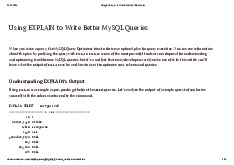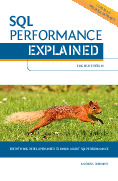



















Preview text:
Database Management and Tuning
Introduction, Tuning Principles, Course Organization Johann Gamper
Free University of Bozen-Bolzano Faculty of Computer Science IDSE Unit 1
Acknowledgements: The slides are provided by Nikolaus Augsten and have been adapted from
“Database Tuning” by Dennis Shasha and Philippe Bonnet. Johann Gamper (IDSE) Database Management and Tuning Unit 1 1 / 39 Outline 1 Course Organization 2
Introduction to Database Tuning 3 Basic Principles of Tuning 4 Conclusion Johann Gamper (IDSE) Database Management and Tuning Unit 1 2 / 39 Course Organization Outline 1 Course Organization 2
Introduction to Database Tuning 3 Basic Principles of Tuning 4 Conclusion Johann Gamper (IDSE) Database Management and Tuning Unit 1 3 / 39 Course Organization Course Organization
Lecture: Tuesday, 10:30-12:30, room A60
Lab: Tuesday, 16:00-17:00, room E431
Office Hours: Wednesday 14:00–15:00
Course info: http://www.inf.unibz.it/dis/teaching/DMT
Feedback most welcome! (gamper@inf.unibz.it or orally) Johann Gamper (IDSE) Database Management and Tuning Unit 1 4 / 39 Course Organization
How to Complete the Course Successfully? Final oral exam: must be passed
you get between 18 and 30 grading points Lab assignments (optional):
you earn 0 to 6 grading points for the lab assignments
late assignments are not considered
Final grade = min(30cl, oral grade + assignment grade) Johann Gamper (IDSE) Database Management and Tuning Unit 1 5 / 39 Course Organization About the Lab Assignments involve: case studies
programming and experimental evaluation study DBMS manual report solutions and results
Assignments have a due data (lab) Assignments must be handed in
via email to gamper@inf.unibz.it
before 16:00 on the due data (i.e., at the beginning of the lab)
Late assignments are not considered – no exception! During the lab hours:
we discuss the previous assignment
you work on the next assignment Johann Gamper (IDSE) Database Management and Tuning Unit 1 6 / 39 Course Organization Topics in this Course Introduction and overview Query tuning Index tuning Concurrency tuning Recovery tuning Hardware and OS tuning Johann Gamper (IDSE) Database Management and Tuning Unit 1 7 / 39
Introduction to Database Tuning Outline 1 Course Organization 2
Introduction to Database Tuning 3 Basic Principles of Tuning 4 Conclusion Johann Gamper (IDSE) Database Management and Tuning Unit 1 8 / 39
Introduction to Database Tuning What is Database Tuning?
Activity of making a database application run faster:
Faster means higher throughput or lower response time
A 5% improvement is significant
Example: To overcome performance issues, a local company bought
additional servers and hard disks. Is this solution scalable?
You should know this and much more about performance improvement at the end of this course! Johann Gamper (IDSE) Database Management and Tuning Unit 1 9 / 39
Introduction to Database Tuning What is Database Tuning?
What parameters should be considered for tuning?
All parameters that help to reach the tuning goal!
Examples: more or faster disks, more main memory, use indexes
effectively, write good queries, avoid unnecessary computations, avoid transaction bottleneck etc.
Bad news: There is always a cost/benefit trade-off.
Good news: Sometimes the cost is very low and the benefit very high, e.g.,
avoiding transaction bottlenecks or queries that run for hours unnecessarily. Johann Gamper (IDSE) Database Management and Tuning Unit 1 10 / 39
Introduction to Database Tuning Why is Database Tuning hard?
The following query runs too slow:
select * from R where R.a > 5 What to do? application sql commands database PARSER OPTIMIZER EXECUTION SUBSYSTEM DISK LOCKING SUBSYSTEM SUBSYSTEM CACHE LOGGING MANAGER SUBSYSTEM hardware DISK/ MEMORY CPU NETWORK CONTROLLER Johann Gamper (IDSE) Database Management and Tuning Unit 1 11 / 39
Introduction to Database Tuning Course Objectives
1. Relevant notions concerning the internals of commercial DBMS
helps you to understand the manual of your DBMS
enables you to take informed tuning decisions
2. Tuning principles, backed by experiments:
How do tuning principles impact performances of my system?
3. Troubleshooting methodology:
Troubleshooting (what is happening?) Hypothesis formulation
What is the cause of the problem?
Apply tuning principles to propose a fix
Hypothesis verification (experiments) Johann Gamper (IDSE) Database Management and Tuning Unit 1 12 / 39
Introduction to Database Tuning Prerequisites Programming skills (Java)
Data structures and algorithms (undergraduate level)
lists, trees, arrays, binary search, merge algorithms, etc.
Databases management systems (undergraduate level) basic SQL knowledge
transactions, indexes, buffer management, etc. Johann Gamper (IDSE) Database Management and Tuning Unit 1 13 / 39
Introduction to Database Tuning
How Is This Course (DMT) Different from the Course
“Database Management Systems” (DMS)?
DMT looks at the same topics from a different perspective.
Algorithmic details vs. black box behavior:
DMS: how exactly does a B-tree update work?
DMT: how efficient is a B-tree update and why? Theory vs. hands-on:
DMS: learn about sort-merge and hash joins on paper
DMT: experimentally compare sort-merge and hash join on a real system, interpret the results Local vs. Global:
DMS: focus on topics in isolation
DMT: focus on interaction between system components
There is a partial overlap, important notions will be revisited! Johann Gamper (IDSE) Database Management and Tuning Unit 1 14 / 39 Basic Principles of Tuning Outline 1 Course Organization 2
Introduction to Database Tuning 3 Basic Principles of Tuning 4 Conclusion Johann Gamper (IDSE) Database Management and Tuning Unit 1 15 / 39 Basic Principles of Tuning
Tuning between Theory and Practice
Practitioner: Apply rules of thumb.
Example: “Never use aggregate functions (such as AVG) when
transaction response time is critical.”
Problem: Blindly applying rules of thumb may not work, e.g., AVG may
be OK if only few tuples are accessed via index.
Theoretician: Mathematically model problem and give guarantees about solution.
Example: Runtime behavior of join algorithms with different indexes.
Problem: Complex approaches often not applicable in practice since
they rest on non-realizable assumptions. Johann Gamper (IDSE) Database Management and Tuning Unit 1 16 / 39 Basic Principles of Tuning
Tuning between Theory and Practice
Database Tuner: Understand and apply principles!
Understanding: The problem is not AVG, but scanning large amounts
of data (which AVG often does...).
Principle: Do not scan large amounts of data in highly concurrent environments.
Understanding the principles is necessary to decide, whether they apply in a particular situation. Johann Gamper (IDSE) Database Management and Tuning Unit 1 17 / 39 Basic Principles of Tuning Five Basic Tuning Principles
Five general and basic principles in tuning: 1. think globally; fix locally
2. partitioning breaks bottlenecks
3. start-up costs are high; running costs are low
4. render on the server what is due on the server 5. be prepared for trade-offs Johann Gamper (IDSE) Database Management and Tuning Unit 1 18 / 39 Basic Principles of Tuning
Think Globally; Fix Locally (I/II)
Tuner should be like a good physician:
think globally: identify the problem (vs. treating symptoms)
fix locally: minimalist intervention (reduce side effects)
Example: Disk activity is very high. What to do?
Solution 1: Buy more disks (local thinking). Disk activity is a symptom.
Global thinking: Where is the disc activity generated?
missing index on frequent query (add index)
database buffer is too small (increase buffer)
log and frequently accessed data share disk (move log to other disk)
Solving the problem is cheaper and more effective than fighting the symptom. Johann Gamper (IDSE) Database Management and Tuning Unit 1 19 / 39 Basic Principles of Tuning
Think Globally; Fix Locally (II/II)
Solution 2: Speed up query with the longest runtime.
Slowest query might be infrequent and take only 1% of overall runtime.
Speedup by factor 2 will increase system performance only by 0.5%! Speed up important queries!
Solution 3: Speed up query with largest share in runtime.
The query that slows down the system might be unnecessary.
Talk to application programmers. Is the query necessary? Can you
achieve the same thing in a simpler way?
Lesson learned: Look at the whole system when you identify the
problem (think globally). Fix the problem where it occurs (fix locally). Johann Gamper (IDSE) Database Management and Tuning Unit 1 20 / 39




